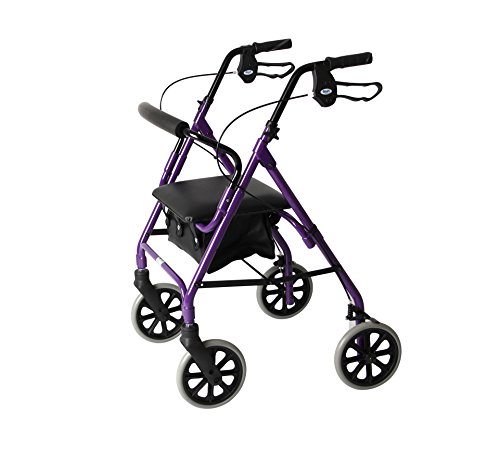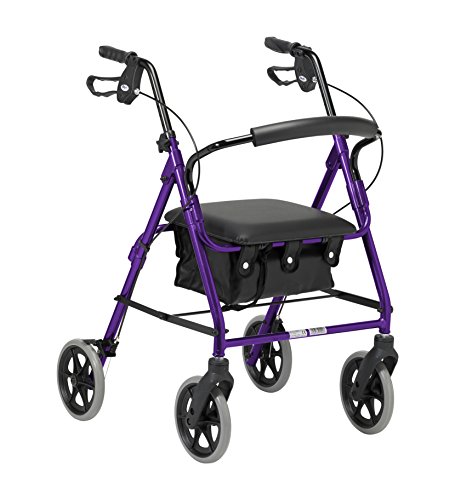Ten Rollator Walking Aid Myths That Aren't Always True
페이지 정보
작성자 Cheryle 작성일24-10-10 04:02 조회11회 댓글0건관련링크
본문
 What Is a Rollator Walking Aid?
What Is a Rollator Walking Aid?A Rollator Walker For Elderly is a form of walking aid that helps individuals maintain their balance. This is done by increasing the base-of-support (BoS) when walking.
 It has brakes which can be easily engaged, and it can lock when the user walks off or sits on the walker. Other features include a comfortable seating area and a baskets to store personal belongings.
It has brakes which can be easily engaged, and it can lock when the user walks off or sits on the walker. Other features include a comfortable seating area and a baskets to store personal belongings.Stability
Rollators provide greater stability and mobility compared to traditional walkers. They are a great option for those who have trouble keeping their balance or need a solid base when walking. These mobility aids can help reduce strain on joints and muscles that are healing, which could promote a faster recovery.
In addition to minimizing muscle strain, these mobility devices have been shown to lessen the strain on lower extremity joints. This is achieved by spreading the weight over an area larger. This could reduce the pressure that is felt in the forefoot while walking on hills or uneven surfaces. The use of these devices can also help reduce pain in the forefoot by distributing pressure from the plantar region to other areas of the foot.
The frame is an essential component of a rollator's strength as it supports the weight of the user. The frame is usually constructed from strong materials such as aluminum or steel which ensures that the device will not buckle or collapse under pressure. Furthermore, the brakes on the handle on rollators are a crucial safety feature for users that allow them to slow down or stop if they're going too fast or picked up too much speed.
The frame of a rolling walker is a solid structure, but it does have its limitations. The weight and size of the frame can influence the device's ability to maneuver through different situations. Some studies have proven that a walker with wheels that are large can cause the center of gravity shift to the front. This could negatively impact the way that the device is utilized.
This is not a problem in the majority of situations, but it should be considered when purchasing a rollator. Because of this, experts recommend that people opt for a wheel that is smaller if they intend to spend a lot of time outdoors or in various walking conditions. Additionally the handle's height should be considered to ensure that they are comfortable for the user. This will avoid wrist fatigue and shoulder discomfort.
Support
Rollators are more stable than traditional walkers, with a frame to help the user. They also come with four wheels that evenly distribute weight and allow users to navigate through various terrains without falling. This allows them to remain active both indoors and outdoors and live an independent life with more confidence. rollators for tall person can be customized by adding various features, including adjustable brakes, handles, and wheel sizes, to meet specific needs. Additionally, some models include a seat for back support and practical storage options to improve daily mobility and comfort.
Although a rollator can provide better stability, it's important that you use it properly to avoid accidents. The most effective way to ensure this is to have an occupational therapist or a doctor supervise your transition using the aid for mobility. They can provide you with written instructions for the device and recommend the best option for your specific situation.
It is also essential that you adhere to the manufacturer's instructions regarding how to use your rollator. This will ensure that it is properly set up at the proper height and fits comfortably with your body shape. It is also essential to keep the device clean and lubricated regularly to improve efficiency.
If you are using a walker that is rolling make sure that you place your weight on the base and not on the wheels. Leaning on the wheels could be a risk to your safety and cause it to roll over. Also, do not let a child ride on top of your mobility aid. This can cause too much stress on the wheels, resulting in them deteriorating quickly.
A few people who require an aid for walking might be hesitant to use one because of its cost. Insurance coverage and financial assistance can assist in reducing costs. For instance, Medicaid and Medicare classify a walker or rollator as durable medical equipment, which means they will pay a portion of the costs. In addition, flexible spending accounts (FSAs) and health savings accounts (HSAs) can be used to pay for these devices too. A rollator is an effective and affordable tool that allows you to remain independent and mobile.
Easy of Use
A rollator is an excellent alternative for those who wish to remain active and mobile but need a little extra support. It is easy to use and can be folded up when not in usage. A rollator can aid in improving walking performance by reducing pressure on joints and muscles and also improving balance.
A typical rollator is a frame with anywhere between two and four wheels. The wheels make it easier to move around as you don't have to lift the frame every time you step. Some models even come with seats, so you can sit down if you need to.
While research is still ongoing, it's expected that using a walker will reduce the load on certain joints and muscle groups while walking. This could lead to less strength required for other movements and activities, such as the climbing of stairs or balance control when standing or squatting. This may contribute to the increased risk of falling among older rollator users.
It is crucial to choose a walker or a rollator that is comfortable for the user. Ideally, the handle should be at the same as the knee closest to it, and should be kept away from the body. Holding a walker too near the body could cause strain on the back, neck and arms. It's also important to take into consideration the grip of a rolling walker. If it's uncomfortable or doesn't meet the user's requirements, it can be substituted with a different type of grip. For example, if the handle is too hard or too small or too small, a grip made from plastic, foam, or other soft material may be more comfortable.
The walker or rollator should be kept at a safe distance from the ground to avoid putting excessive pressure on the feet and legs. This will lower the risk of tripping or twisting an ankle or knee. It's also a good idea to have an alternate device (like a cane or crutches) in case the walker that rolls is unstable due to any reason. It's not recommended to put the rollator on the ground for long durations, particularly on uneven or sloping ground.
Convenience
A rollator is a useful mobility aid for those who have difficulty walking long distances or suffer frequent falls. It can help reduce the impact and strain on injured muscles or joints. It can also boost confidence and help with social engagement. It's important to consider the cost of a rollator and whether your insurance will cover it. Many Medicare Part B policies classify walkers and rollators as durable medical equipment and will therefore reimburse some of the cost once you've met your annual deductible. Medicaid typically covers these devices.
Some people utilize rollators as an alternative to a walker or cane however, it's better to keep using these other devices for stability and support while walking. For example, a walking aid can help you maintain an upright posture by keeping your forearms aligned with your hips. In addition you can keep it at a comfortable and comfortable distance from your body which helps prevent curious positions which could result in an injured knee or ankle.
It is important to keep in mind that if you decide to use a walker, you should never hold it against your body or near. Handles on a standard walker tend to be higher than the user's arms. This can result in wrist flexion. This could aggravate the flexor muscles of the hands and arm, which can result in forefoot pain, or a hallux rigidus. A rolling walker reduces this issue by lowering the handles to a position that is more in line with the processus styloideus ulnae.
The majority of rollators have a seat, which can be used in public places or while running around. This is particularly helpful when you're shopping and need to rest your legs. Some models come with an oversized tray that sits on the top of the seat. This lets you carry drinks or snacks while walking around.
Finally, consider whether your device comes with storage for items such as your keys, phone and wallet. Some models come with a basket at the front of the frame, while others have storage under the seat. Some walkers that roll are equipped with a backpack strap for ease of transport.
댓글목록
등록된 댓글이 없습니다.














